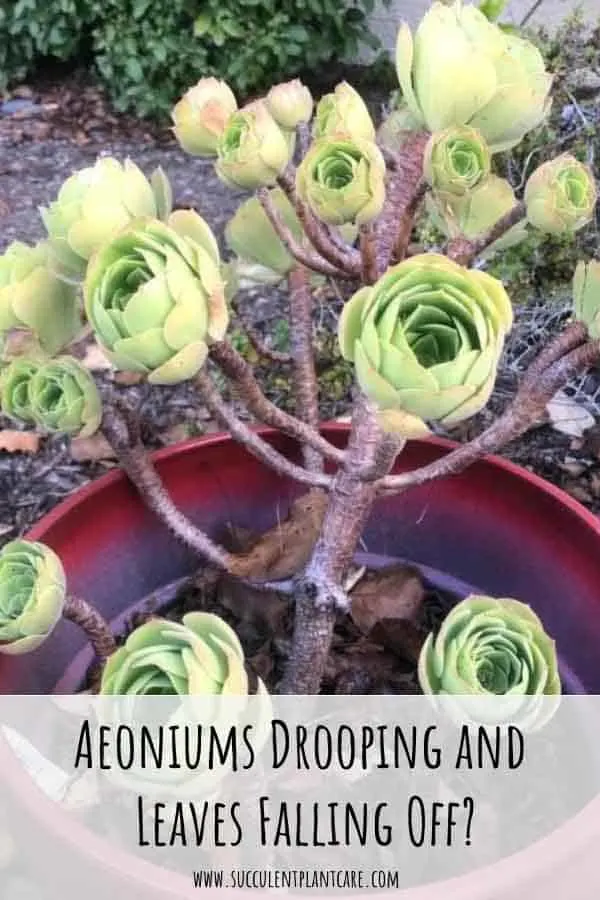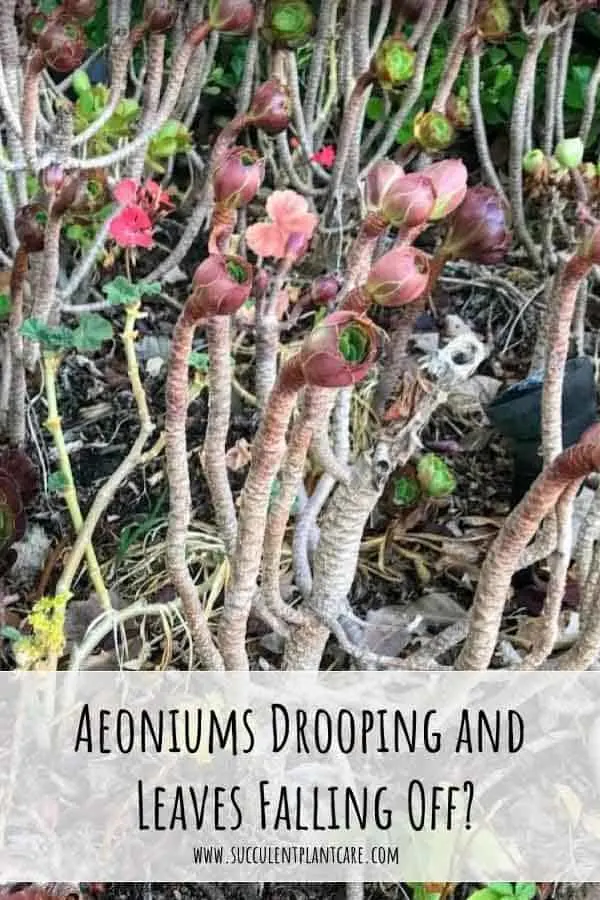Aeoniums may seem puzzling at first, but I have learned a lot over the years in how to care for them. In fact, they have become one of my go-to succulents because of how easy and reliable they have been.
If your aeoniums are showing signs of stress such as drooping or falling leaves, there’s usually a reason and a quick solution for them.
Let’s take a look at some of the likely reasons for dropping leaves and droopy aeoniums.
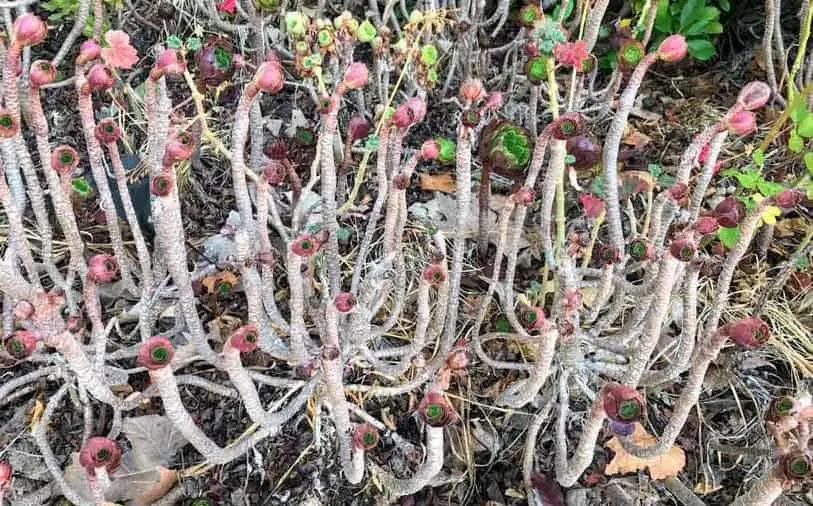
Aeoniums Dropping their Leaves–Is this Normal?
Aeoniums drop their old leaves from the bottom up. It is completely normal for aeoniums to drop old leaves as new ones develop. Aeoniums tend to drop or shed old leaves more so than other succulent plants. These leaves often appear wilted, dried up and sometimes droopy.
If the leaves don’t fall off on their own, they will appear droopy, some dried up and brown, on the bottom of the plant. These leaves will easily come off and you can pull them out if you want or leave them alone and wait for them to fall off on their own.

If you notice leaves dropping off your aeoniums, it’s usually not a concern and they are displaying normal behavior.
Aside from dropping or shedding old leaves as new ones grow, aeoniums also shed their leaves when they go through dormancy and also when under stress. Read on to find out more.

Aeoniums Shedding All of their Leaves and Drooping–Are they Dying?
When your aeoniums have shed most of their leaves and look like they are dying, most likely they are just going through dormancy. Unlike other succulents, aeoniums’ active growth period is during fall, winter and spring seasons.
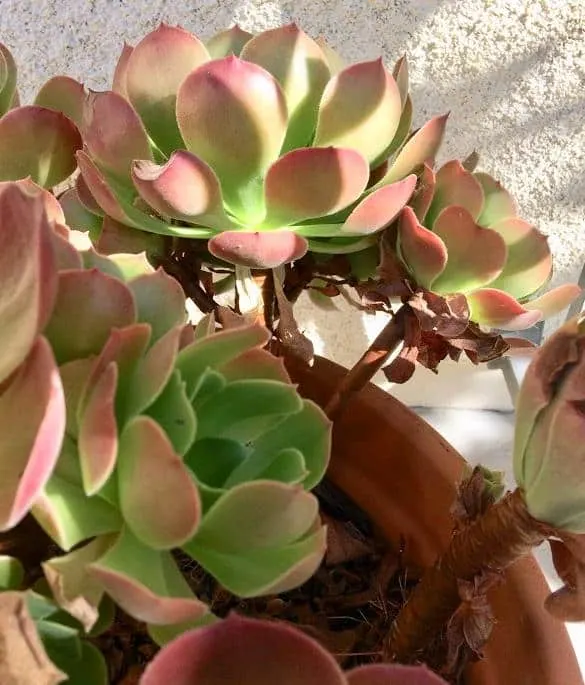
They go dormant in the summer or during really hot and dry weather conditions, especially when left outdoors in the summer heat.
This is when you see the aeoniums shed a lot of the bottom leaves so that it seems as if most of the leaves are gone, and the rosettes start to close up, and it appears as if the plant is drooping and the stems appear bare. It may look as if the plant is dying and not doing well at all but his is totally normal behavior for aeoniums, especially those exposed to extreme heat and sun in the summer months.
This is when the aeoniums go through dormancy and not much activity or growth is expected. This is also the time when you want to leave the plant alone and not do anything drastic with the plant. You wouldn’t want to take stem cuttings, for instance, from a dormant plant.
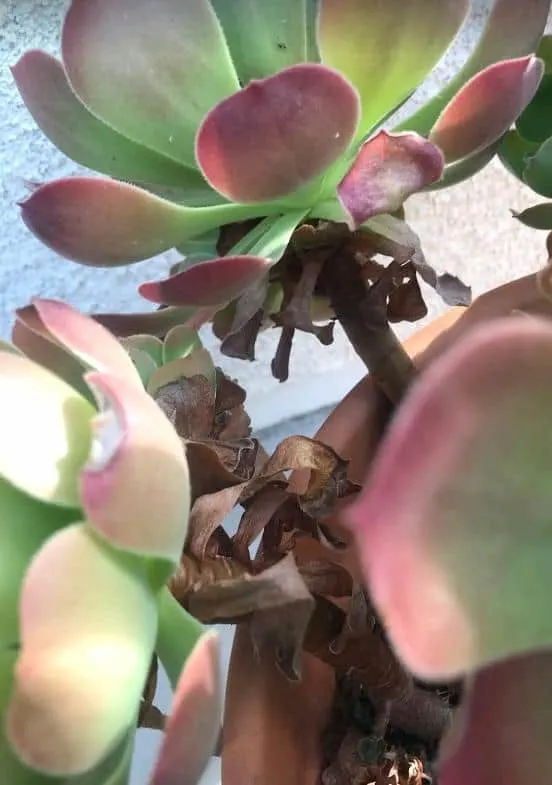
Or you do not need to panic and start loading the plant up with fertilizers. Just let the plant rest during this time. I still water my plant as is during dormancy only because it is very dry and hot where I am and I don’t want them to completely dry out.
Some people do not water their aeoniums during dormancy, and that is fine if you live in a humid climate. Dormancy usually takes place once a year, during the summer months. However, depending on where you live and the location of your aeoniums, the plants can enter dormancy at any given time, as long as they are exposed to extreme heat and dry conditions.
For example, you can be going through a heatwave during a particularly warm fall season. The aeoniums will go through the same dormancy behavior even if it’s not in the summer months.
Dormancy can take place based on the current weather conditions and not entirely on the season. So if you’re experiencing a mild summer with not much intense heat, the aeoniums can also skip dormancy altogether.
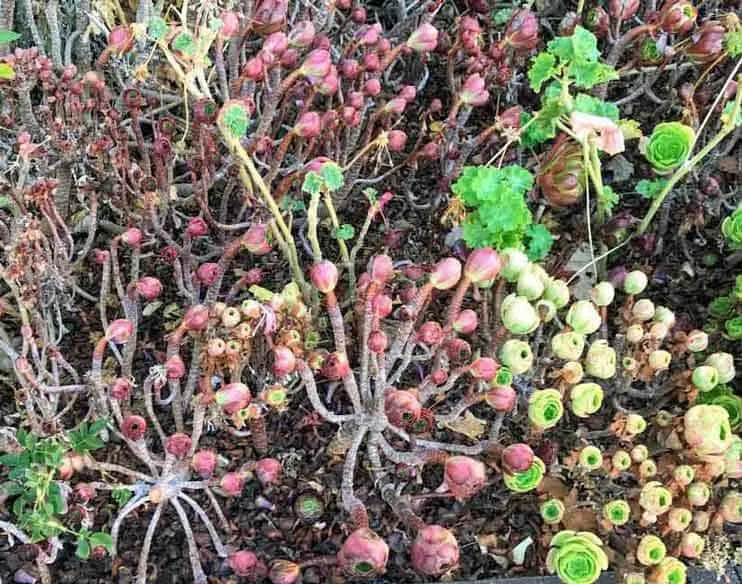
Aeoniums Will Shed Leaves when Under Stress
Aeoniums also shed leaves under stress, such as during an intense heatwave, or when underwatered. To conserve energy and water, an underwatered aeonium will shed its bottom leaves and if underwatering continues, the aeonium will continue to shed leaves and the rosettes will close up.
They will look and go through the same behavior as if they are going through dormancy.
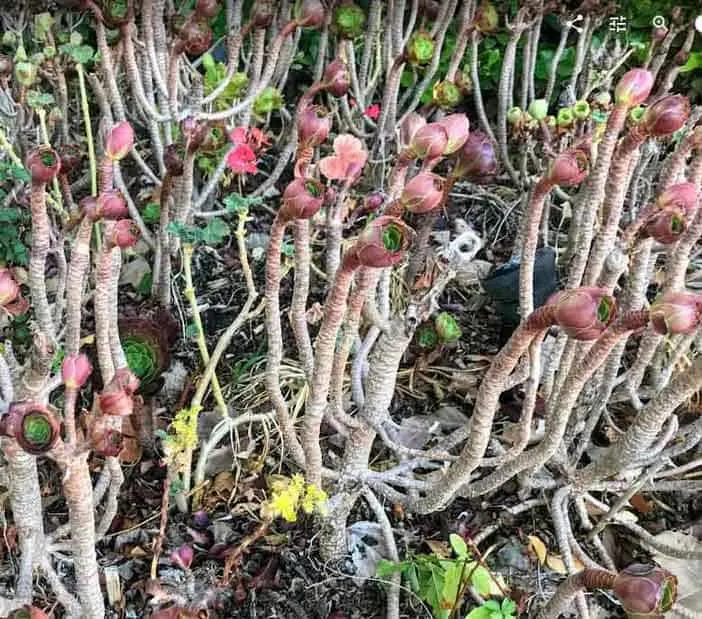
This is the plant’s way of conserving much needed energy and water to survive. I find aeoniums needing a little more water than other succulents. If they are not receiving enough water, the leaves will curl, dry up, and fall off.
Aeoniums like to be watered thoroughly. I never mist my aeoniums but instead give them a good drink every 10-14 days or so, and more during warmer months. Again, I live in a very dry climate. You do not need to water as much if you live in a humid environment.
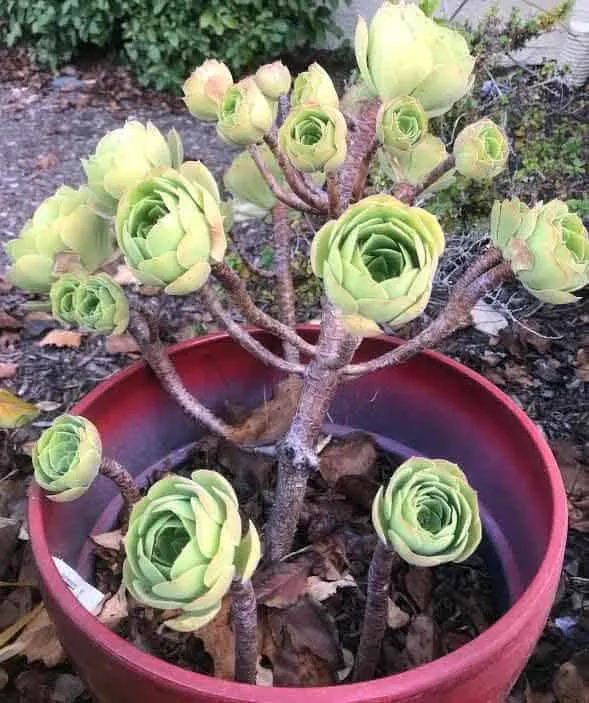
If you’ve been underwatering your aeoniums and you’ve noticed these signs start to happen, simply increase watering and they will perk back up almost immediately. So if you’ve been watering once a month, increase watering to once every 2-3 weeks and see what happens.

Aeonium Leaves Turn Brown and Fall Off from Sunburn
Aeoniums prefer a bright and sunny location. They can take full sun to partial shade. Aeoniums can get sunburned from time to time, even the ones that have been acclimated to full sun. Sunburned leaves will appear scorched, brown and dried up.
The extent of the sunburn or sun damage will depend on the sun exposure and intensity. Sunburn can appear on a few leaves, or it can be on the entire plant or rosette. Sunburned spots on the leaves are permanent and will not go away.
You can pull the sunburned leaves out if you want, or you can wait until they eventually fall off. If the entire plant or rosette is sunburned, there is very little you can do to improve the appearance of the plant. You just need to wait until the plant develops new growth and gets rid of the sunburned portions.
If you notice your plant being sunburned, you can move the plant to a shadier location. While aesthetically not pleasing, sunburned spots on aeoniums are harmless and will fall off on their own.
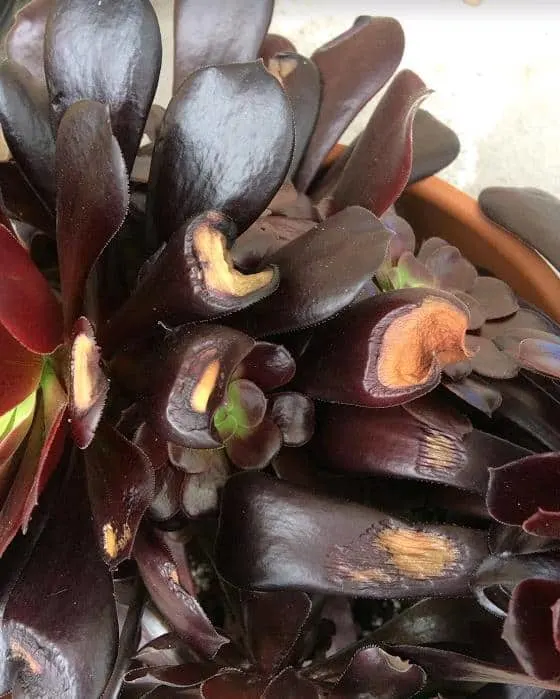
Aeoniums are Monocrapic–They Die After Flowering
Most aeoniums are monocarpic plants and die after flowering. Aeoniums produce white or yellow flowers that shoot out from the center of the rosettes. Once the flowers are done blooming, the plant dies. What typically happens is that the mother plant produces plenty of offshoots before it flowers. It usually takes a number of years before aeoniums flower and then die. By then, they would have produced plenty of offshoots to keep the plants going, even if the mother plant flowers and dies. The surrounding rosettes and offshoots will continue growing as long as they do not flower.
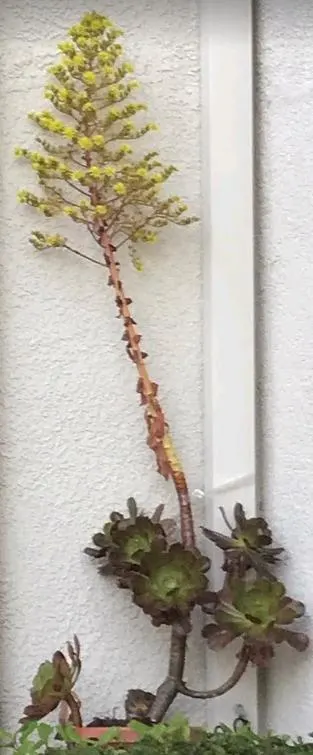
What Could be Eating my Aeoniums?
While aeoniums are some of the hardiest succulents I know, they are not immune to pests and that bug succulent plants. If you think you have a problem with insects eating your aeoniums, your hunch may be right. In fact, my aeoniums were hit hard last year by garden pests.
If you start noticing busy ants around your aeoniums, take a closer look. Ants may seem harmless, but if there are a lot of them on your plant, it is usually a sign of trouble which means you have an infestation of other pests going on. Because these pests are so small, they are very easy to miss.
Once you spot ants around your aeoniums, you can be sure to find other pest infestations going on. That’s because ants bring these pests to your plants and protect them like cattle. That’s what happened with my aeoniums. The good news is, they seem to be doing well and have proven that they really are hardy, resilient plants even after all that they’ve been through.
Common Pests that can Bug your Aeoniums:
Ants–Ants are not pests per se, but when you see them all over your aeonium, you need to take a closer look because it is a sure sign that you have other pests such as mealybugs and aphids on your plant. That’s because ants farm these pests and use them as a food source.
Aphids and mealybugs secrete honeydew or these sugary substance that ants love. Ants protect these pests and can transport them from one plant to another.
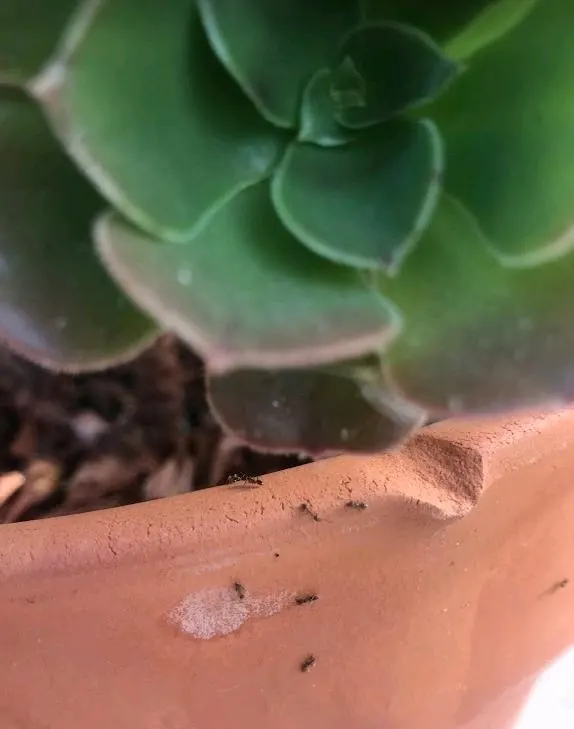
Mealy Bugs–These are one of the most common pests in succulents and aeoniums are particularly susceptible to them. They are tiny and easy to miss. They get their name from a waxy or mealy white material they produce.
An early sign your plants have mealybugs is the white cottony substance you see on your plants. Chances are you’ll spot these white fluff first before spotting the bugs. These insects secrete honeydew or a sugary substance, which can promote the growth of mold and make the plan more susceptible to bacterial and fungal infections.
Mealybugs are slow moving insects and can be easily recognized and removed once you know what you are looking for. You can usually spot them on the leaves or the underside of leaves, and between the joints of the plant. They can easily spread from plant to plant.
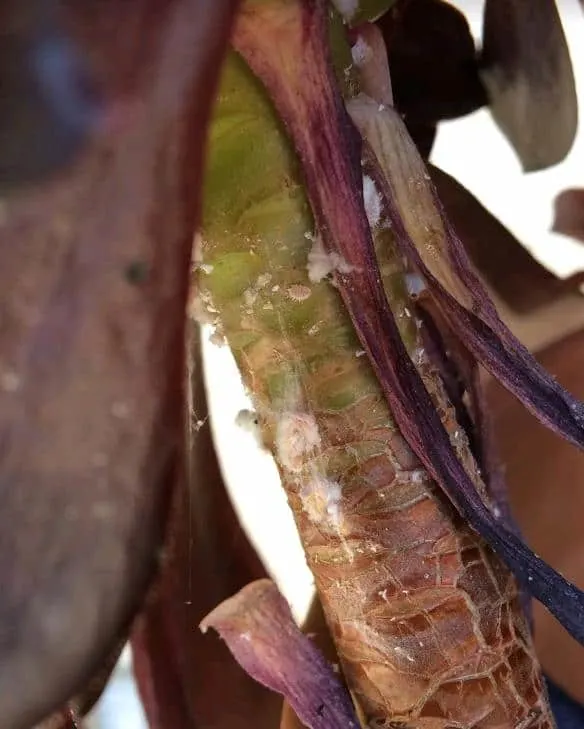
Aphids (Greenflies or Plant Lice)–These are small insects with fat, teardrop-shaped bodies. They come in different colors but the most common is green or black. They can be found sucking on leaves or flowers at the end of the stems.
They also secrete a lot of sugary white substance or honeydew. This sugary substance can encourage the growth of black sooty mold. Aphids suck on the plant’s tissues, causing the plant to have misshapen leaves and stunted growth.
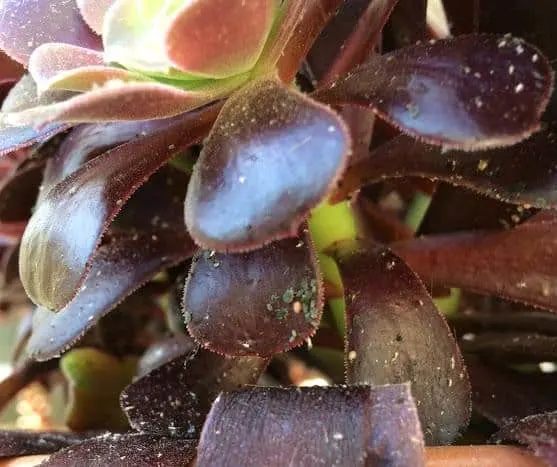
These pests are very easy to miss because they are so tiny and they can be hiding underneath the leaves. It is a good idea to inspect your plant from time to time, get rid of old leaves on the plant, in the pot or the ground to prevent these little insects and pests from hiding and taking residence on your plant. And the minute you see ants around your aeoniums, you want to take action right away.
To read more about pest infestations on aeoniums and how to treat them, please click on the following articles:
“How to Treat for Ants, Mealybugs and Aphids on Succulents”
“Easy Treatments for Common Pests on Succulents”
To check out products you can use to treat pests, please click on my resource page for recommendations.
Where can you find aeoniums? Check out my resource page for recommendations on where to purchase these and other succulent plants online.
Pin this now to save for later or share with others!
